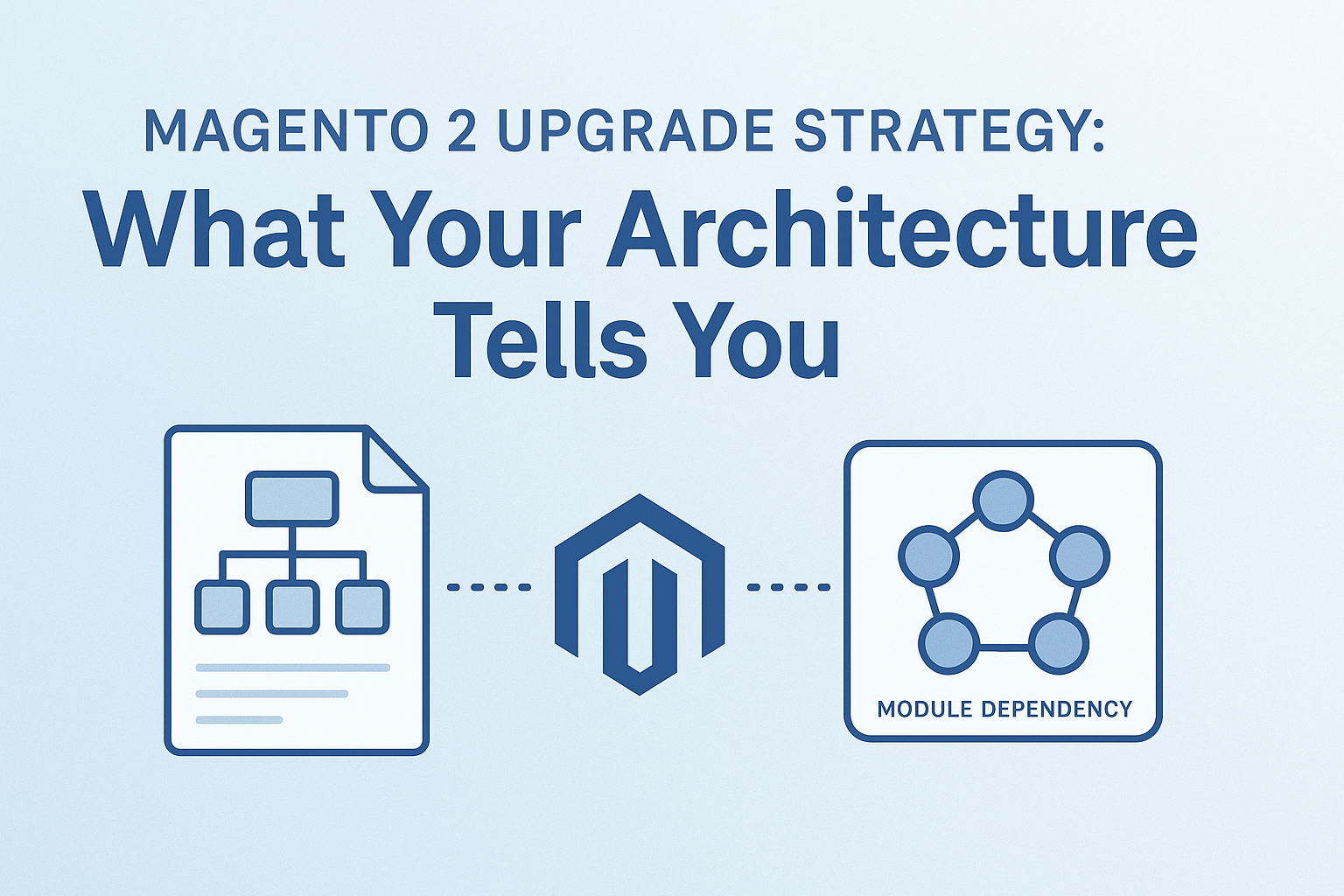Create a Customer-Centric Website Experience with Magento 2
Magento 2 is designed to make backend operations highly integrated and efficient, so you can customize your site for optimal customer experience.
6 min read
 Jeff Zoldy
:
September 26, 2023
Jeff Zoldy
:
September 26, 2023

Customizing the Magento platform is a highly specialized field that demands a substantial level of expertise in Magento development to achieve optimal outcomes. It encompasses different facets of development, each typically necessitating varying degrees of website development skills and resources.
In this article, we'll delve into why customizing your eCommerce site is essential, what aspects of the Magento platform can be customized, and the best practices, pitfalls, and benefits associated with Magento customization.
There are a handful of high-level reasons why you should customize your Magento site. Let’s take a look at a few key points:
Whether you are using Magento Open Source or Adobe Commerce to build your site — both of which are built on the Magento codebase — customization remains a pivotal aspect of your site. The good news is there's no significant difference between the two in terms of the customization process: both will require a development team or Magento development agency partner, as Adobe itself typically doesn't get involved in custom development.
For a more detailed discussion on choosing between freelance developers, in-house developers, or agencies for your customization needs, read this.
When it comes to Magento customization, the possibilities are extensive — almost endless, in fact. Here are some areas you can focus on:
While configurations are not technically customizations, these adjustable settings with the Magento admin area can have a sizable impact on the speed and usability of your website. Some examples of configurations include:
In addition to the configurations available natively with the Magento admin, modules and custom features may add configurable elements to the admin area.
The two most impactful configurations you can work with will be site security and cache management. The site security elements will help reduce the risk of security breaches, while careful cache management will help improve the speed of your site and the consistency of your data.
Magento and Adobe Commerce use a collection of front end code referred to as a theme. This theme is more than just the way the site looks.Themes provide the overall site structure as well as core functional elements to be displayed on the front end of the site. There are thousands of pre-built themes available for free or for a fee. Some are developed well, while others will only add to your technical debt. Some businesses can get by with a theme that is already well designed for their business needs, but more often a business has specific needs requiring theme customizations.
These theme customizations will require skilled developers to perform the work to ensure proper functionality, efficiency and long term usability.
Both Adobe Commerce and Magento Open Source have massive libraries of pre-built modules or extensions available to add features to the native platform capabilities. However, in some cases, specific business needs require a custom development to build out a particular function or integration. Customized extensions can involve customizing existing third-party extensions or building a completely custom extension tailored to your specific needs. The term “extension” is broad and can be related to frontend, admin, or other functionalities — so there are a lot of areas that can be customized.
Integrations are essential for linking Magento with other systems or services. While many third-party integrations are readily available, some systems might not have suitable extensions. — and even if a third-party extension exists, it might not meet your specific requirements in terms of quality or functionality. Custom integrations bridge these gaps and help data flow between systems. Common integrations are between your eCommerce platform and the following systems:
The goals of a thoughtful integration are primarily to reduce redundant data entry and management, while also sharing accurate data consistently across systems for more efficient user experience both internally for the business operations and for the customers engaging with your website.
Let’s look at a few high-level best practices and pitfalls when it comes to customizing your Magento store.
Research is key to successful customization. Before embarking on any customization project, be sure to identify concrete business needs that your Magento customization will address. Understanding your specific requirements and goals will help guide the customization process and help you make informed decisions when it’s time to execute.
Likely the main drawback of customization is the potential for increased complexity of your website. While customization can deliver long-lasting benefits, it can also lead to long-term costs – maintenance, compatibility with future site upgrades, and ongoing testing to ensure the customizations work as expected. These factors contribute to the complexity and price to maintain your online store. Do not neglect the future work and potential complexities that your customization will cause.
We can’t stress this enough: do not take shortcuts when customizing Magento, especially when it comes to design. This applies to both functional and frontend design. Considering use cases during the design phase can help ensure that your customization aligns perfectly with your business goals. Use cases also play an important role in testing to verify that the customization performs on your site as intended.
It goes without saying that quality code is non-negotiable when it comes to customization. This principle applies to anything you build, but it's especially important in the context of Magento. Adhering to best practices for Magento's codebase ensures the long-term stability and performance of your online store — regardless of whether you're using Adobe Commerce or Magento Open Source.
A corresponding pitfall exists for each best practice we’ve discussed, often stemming from bad planning and/or implementation. For example, poorly written and implemented code can negatively impact your site's speed and security, as well as potentially costing you sales in the long run. It's essential to prioritize quality control and implementation at every step of the process to make sure your efforts do not go to waste.
Magento and Adobe Commerce customization offer a wide range of benefits, including:
Magento customization is a powerful tool that can help your business thrive in the increasingly popular eCommerce space. However, it needs to be approached with careful planning, adherence to best practices, and a keen awareness of potential pitfalls. When done right, customization can unlock the full potential of your Magento online store, providing a personalized and seamless shopping experience for your customers while delivering tangible business benefits like increased traffic and sales.
Magento customization involves modifying and enhancing the Magento platform to meet the specific needs of your eCommerce store. This can include changes to the design, functionality, and user experience. Customization is important because it allows you to create a unique and tailored shopping experience that aligns with your brand, improves customer engagement, and can drive higher sales and conversion rates.
Common customization options in Magento include custom themes and templates to reflect your brand's look and feel, personalized product recommendations, custom checkout processes, integration with third-party services (such as payment gateways and shipping providers), and advanced SEO optimizations. You can also add unique functionalities like customer loyalty programs, special promotions, and product configurators.
Absolutely! Magento is highly flexible and can be customized to integrate with a wide range of systems and tools, including CRM systems, ERP solutions, payment gateways, shipping services, and marketing automation platforms. These integrations help streamline your operations, improve efficiency, and provide a seamless experience for both your customers and your team.
Magento customization can significantly enhance the user experience by providing a more intuitive and engaging shopping journey. Custom features like personalized product recommendations, easy navigation, quick view options, and streamlined checkout processes make it easier for customers to find and purchase products. Additionally, a custom-designed website that reflects your brand’s identity can create a more memorable and enjoyable experience for visitors.
While some basic customizations can be done using Magento’s built-in tools and extensions, more advanced customizations typically require the expertise of a developer. A professional developer or development agency can ensure that your customizations are implemented correctly, efficiently, and securely. They can also provide ongoing support and maintenance to keep your site running smoothly.

Magento 2 is designed to make backend operations highly integrated and efficient, so you can customize your site for optimal customer experience.

Planning a Magento 2 upgrade? Learn how your site’s architecture—modules, custom code, and APIs—can guide a safer, smarter upgrade strategy that reduces risk and improves long-term stability.

Discover the best Magento modules and plug-ins to enhance your e-commerce store's functionality, from SEO optimization to customer experience.